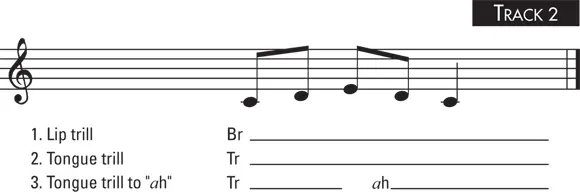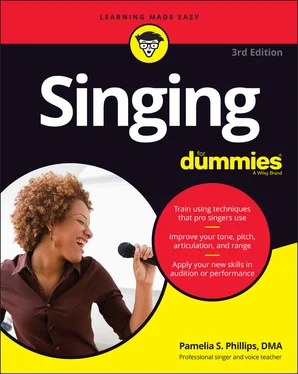3 Play the track for a third time, alternating between doing the tongue trill and singing on the given notes.You can easily go right from the tongue trill to a vowel. For example, sing the first two notes on the tongue trill and the last two notes on ah. Make a smooth transition from the tongue trill to the ah. See whether your airflow remains the same.

© John Wiley & Sons, Inc.
FIGURE 4-1:Lip and tongue trills.
Recognizing resistance and suspending the breath
Singers often think that they can control their diaphragm movement and achieve great breath control. What most people don’t know is that the diaphragm is passive during exhalation. Your diaphragm moves down as you inhale and as your lungs expand to fill with air, but the diaphragm isn’t active when you exhale. You control exhalation by controlling all the muscles that affect the movement of the lungs — the muscles between the ribs (intercostals), the muscles on your sides (obliques) and your back, and your abs. Knowing how to control the movement of these muscles controls your exhalation and allows you to sing long phrases. Refer to the section, “ Tackling the Basics of Breathing,” earlier in this chapter for more information.
 Because your body is used to opening for the inhalation and then a quick exhalation, you have to resist the normal movement of your body when you’re singing. This resistance is a good thing. Think of resistance as a slow movement of the body back in for exhalation, or a friendly resistance to keep the body from collapsing.
Because your body is used to opening for the inhalation and then a quick exhalation, you have to resist the normal movement of your body when you’re singing. This resistance is a good thing. Think of resistance as a slow movement of the body back in for exhalation, or a friendly resistance to keep the body from collapsing.
One way to explore exhalation and resistance is to suspend the breath. If the normal movement of your body is to take a breath and gradually exhale, or allow the body to move back to its resting position, I want you to explore taking a breath and then waiting before you exhale. It feels like your body is suspended in motion: You’re ready to exhale, but the muscles just aren’t moving yet. This feeling of suspension is what I mean by resistance.
Your body wants to close, but you aren’t allowing it to collapse just yet. Resistance doesn’t involve tension; it’s more like hesitation. Notice the feeling of your body staying open as you take the breath and then wait. You can practice suspending for three or four counts and then gradually exhale. The goal isn’t to figure out how to suspend for long periods of time, but to understand the sensation of the body resisting the normal urge to close after an inhalation.
Try this sequence to develop your ability to suspend the muscles of exhalation:
1 Breathe in for three counts.
2 Suspend for three counts.As you suspend, pay attention to the sensations in your body. Your body wants to close, but you make the choice to suspend and stay open.
3 Exhale for three counts.
4 Gradually move the exhalation number higher.Inhale for three counts, suspend for three counts, and exhale for four counts. Notice how your body adjusts to the slower exhalation.
You can exhale in one count or in ten counts, and the body adjusts the movement of the muscles. For today, I recommend that you try the sequence with three counts for each step. Tomorrow you can move the exhalation up to four counts, and the next day move the exhalation to five counts. Explore this exercise slowly to develop control over the muscles. Moving too quickly doesn’t allow you to explore the sensations of adjustment in your body as the exhalation gets longer. The next section in the chapter has more exercises that explore longer exhalation.
Testing Your Breath Control
If you’ve been working on the exercises in this chapter, you’ve probably explored your inhalation and exhalation enough to know what’s moving and grooving as you breathe and sing.
Athletes know that they have to train consistently to teach the muscles in their body to respond exactly the way they want. Gaining coordination of the muscles that control breathing takes time and consistent practice. Some people call it developing muscle memory. Over time, the muscles remember how to move and you don’t have to think about it. You want this to happen for breathing and singing: You want to practice the breathing exercises enough that you can rely on them to work efficiently so you can focus on the story you’re telling.
Athletes also know that working out and doing physical conditioning is crucial for developing the ability to transport oxygen quickly throughout the body. When you’re singing, you’re moving a lot of air, and your body needs to be in good shape so you can handle the endurance required to sing for an entire performance. You don’t have to be thin, but you have to be in good shape. Your workout at the gym also helps your breathing for singing.
Pushing yourself just a little beyond your comfort zone helps you develop stamina and endurance. Your muscles may feel warm or tired after you work on the breathing exercises, which is perfectly normal. Extreme fatigue is a sign that something isn’t right in your practice session, but it’s normal to feel tired and need to rest for a time before you can practice more.
To give yourself an opportunity to work on more advanced breathing exercises, keep reading and working through the exercises. They aren’t too advanced for you, especially if you’ve been exploring other exercises and are comfortable with what moves as you breathe.
 If you’re new to singing, moving too quickly to the advanced exercises without practicing the basics doesn’t give you an opportunity to make the movement a habit. It took some time for me to make efficient breathing a habit, but now I don’t have to worry about changing gears when it’s time to sing. I breathe in the same manner when I sing as when I speak because the movement has become so natural for me.
If you’re new to singing, moving too quickly to the advanced exercises without practicing the basics doesn’t give you an opportunity to make the movement a habit. It took some time for me to make efficient breathing a habit, but now I don’t have to worry about changing gears when it’s time to sing. I breathe in the same manner when I sing as when I speak because the movement has become so natural for me.
Releasing abs and then ribs
Because your lungs are housed within your rib cage, allowing the ribs to open as you inhale and letting them stay open as you exhale is beneficial. This is also known as outie breathing, or appoggio (that’s Italian for “support” or “lean”). Don’t force your ribs to stay open, but allow them to stay open. Even if the words force and allow seem similar, they’re different. Forcing the ribs to stay open results in pressure being put on your body and a tight sound.
When you’ve been working with breath for some time and you can easily manage quick, efficient inhalation and have some control over longer exhalation, try the exercise that follows.
1 Practice flexing open your ribs.Stand in front of the mirror and try to open your rib cage. You want to open your ribs on the side of your body, not raise your chest. Watch the movement in your body to make sure that you’re not lifting your chest. It may take a few tries before you can figure out how to open the ribs. When you know how to move them, allow the ribs to open as you inhale. The area that you’re trying to move is at the bottom of the rib cage.
2 Inhale and open your ribs.Practice inhaling and allow your ribs to open. If you aim the air at the lowest rib, you can open the ribs without forcing your chest to rise.
3 Work for a time just allowing your ribs to open when you inhale and to close as you exhale.As this becomes easier, allow the ribs to stay open longer on the exhalation.
Читать дальше


 Because your body is used to opening for the inhalation and then a quick exhalation, you have to resist the normal movement of your body when you’re singing. This resistance is a good thing. Think of resistance as a slow movement of the body back in for exhalation, or a friendly resistance to keep the body from collapsing.
Because your body is used to opening for the inhalation and then a quick exhalation, you have to resist the normal movement of your body when you’re singing. This resistance is a good thing. Think of resistance as a slow movement of the body back in for exhalation, or a friendly resistance to keep the body from collapsing.










